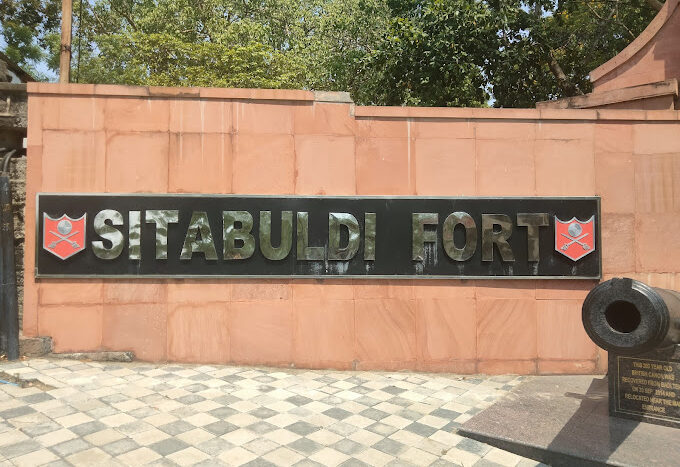Sitabuldi Fort in Nagpur: History, Amenities, and Real Estate Insights
Nestled in the heart of Nagpur, Maharashtra, Sitabuldi Fort stands as a proud reminder of the city’s rich history and cultural heritage. Perched atop the twin hillocks of Badi Tekri and Choti Tekri. This fort is more than just a historical monument, it’s a symbol of Nagpur’s resilience, strategic importance, and its role in shaping India’s past. For locals and tourists alike, Sitabuldi Fort offers a fascinating glimpse into the region’s colonial and pre-independence history, coupled with breathtaking views of the bustling city below.
In this blog post, I’ll take you on a journey through the fort’s storied past, its unique features, nearby accommodations, real estate opportunities, quick facts, and any known expansions. Whether you’re a history buff, a curious traveler, or a Nagpur local looking to rediscover your city. This guide will help you appreciate the charm of Sitabuldi Fort.
You might like: Nagpur Mahal Uncovered: Your Ticket to History, Hotspots & Hot Properties!
About Sitabuldi Fort: A Historical Marvel
Sitabuldi Fort is more than just a structure of stone and mortar; it’s a living testament to Nagpur’s pivotal role in India’s history. Located in the bustling Sitabuldi area, a commercial hub of the city. The fort’s elevated position offers panoramic views of Nagpur’s vibrant skyline. Its strategic placement on the twin hills made it a key military outpost in the past, and today. It remains an active military base under the care of the Indian Army’s 118th Infantry Battalion (Territorial Army) Grenadiers.
History of Sitabuldi Fort
The story of Sitabuldi Fort begins in the early 19th century. A time of intense political and military upheaval in India. The fort’s origins are tied to the Third Anglo-Maratha War (1817–1818). A defining conflict that marked the decline of the Maratha Empire and the rise of British dominance in central India. While some sources suggest that the fort’s initial foundation was laid in 1702 by Raja Bhakta Buland Shah, a Gond king, it was significantly rebuilt by Mudhoji II Bhonsle, also known as Appa Sahib Bhosle, of the Bhonsle dynasty of Nagpur. Just before the Battle of Sitabuldi in 1817.
The Battle of Sitabuldi (1817): This battle was a turning point for Nagpur. The Marathas, led by Mudhoji II Bhonsle, clashed with the British East India Company. Who sought to expand their control over central India. The fort’s elevated position on the Sitabuldi Hills gave the British a strategic advantage. Allowing them to fend off the Maratha forces. The British victory solidified their control over Nagpur, and the fort was reconstructed under the supervision of Captain Charles Jasper to serve as a permanent military stronghold. The fort’s utilitarian design, built with sandstones, granite, and laterite stones, reflects the urgency and practicality of colonial military architecture.
Role in India’s Freedom Struggle: Beyond its military significance, Sitabuldi Fort played a role in India’s fight for independence. In the early 1920s, the fort was used as a detention center for political prisoners. One of its most notable detainees was Mahatma Gandhi. Who is believed to have been imprisoned here in 1923 (though some historical accounts debate this). A cell within the fort is marked as Gandhi’s detention site, serving as a poignant reminder of the freedom struggle. Additionally, a war memorial within the fort commemorates soldiers. Who lost their lives during the Battle of Sitabuldi and other conflicts, adding to its historical weight.
Cultural and Historical Significance: Over the years, Sitabuldi Fort has evolved from a military outpost to a cultural landmark. It has hosted significant figures, including King George V and Queen Mary. Who made a public appearance from the fort in the early 20th century. The fort also holds a somber history tied to the execution of Kadhar Ali Nawab. A grandson of Tipu Sultan, and his supporters, who were hanged and buried here during the freedom struggle. A mosque built in their memory stands within the fort’s premises, adding to its layered history.
Today, the fort is a protected monument maintained by the Indian Army. Open to the public only on select national holidays. Republic Day (January 26), Maharashtra Day (May 1), and Independence Day (August 15). These days feature flag-hoisting ceremonies that draw crowds of locals and visitors eager to explore the fort’s grounds and soak in its historical ambiance.

Amenities at Sitabuldi Fort
Given its status as an active military base, Sitabuldi Fort does not offer extensive amenities for visitors. The focus here is on preserving the fort’s historical integrity rather than turning it into a commercial tourist spot. However, there are a few basic facilities and features that enhance the visitor experience:
War Memorial and Historical Markers: The fort houses a war memorial dedicated to soldiers who perished in the Battle of Sitabuldi and other conflicts. Plaques and inscriptions provide historical context. Making it a reflective spot for visitors.
Panoramic Views: The fort’s hilltop location offers stunning views of Nagpur’s cityscape, making it a great spot for photography (though restrictions may apply in certain military areas).
Guided Tours (Limited): On open days, local guides may be available to provide insights into the fort’s history. Hiring a guide is recommended for a deeper understanding of its significance.
Basic Infrastructure: The fort has limited facilities like parking near the base of the hill. But visitors should be prepared for a short walk or climb to reach the main structure. There are no on-site shops, restrooms, or food stalls. So visitors are advised to carry their own water, snacks, and essentials.
Photography Restrictions: While photography is generally allowed, certain areas under military control may have restrictions. Always check with authorities before taking photos.
Accessibility: The fort is accessible by foot, but the climb can be tiring for some visitors, especially the elderly or those with mobility issues. Comfortable walking shoes are a must.
For a comfortable visit, plan to arrive early in the day, especially during the cooler months (August to March), to avoid the heat and crowds. The fort’s serene atmosphere and historical significance make it a rewarding experience, even with minimal amenities.
Hotels Near Sitabuldi Fort
Given Sitabuldi Fort’s central location in Nagpur, there are plenty of accommodation options nearby, catering to a range of budgets and preferences. Whether you’re a tourist visiting for a day or a local planning a staycation. Here are some top hotels within a 2-km radius of the fort, based on traveler reviews and proximity:
Hotel Hardeo (0.8 km from Sitabuldi Fort): Located on Dr. Munje Marg, this budget-friendly hotel is known for its clean rooms, courteous staff, and proximity to Nagpur Railway Station (1.5 km). Guests appreciate its reasonable food and laundry charges, though some note that the furniture is dated. Ideal for travelers seeking affordability and convenience.
Treebo Trend The Pavilion (1.5 km from Sitabuldi Fort): A 3-star property near Nagpur Railway Station, this hotel offers well-sanitized rooms, modern amenities, and a warm ambiance. It’s a great choice for families or business travelers looking for comfort and safety.
Radisson Blu Hotel (approx. 4 km from Sitabuldi Fort): For those seeking luxury, this 5-star hotel, a 10-minute drive from the fort, offers spacious rooms, a fitness center, and excellent dining options. While pricier, it’s praised for its outstanding facilities and proximity to Dr. Babasaheb Ambedkar International Airport.
JK Rooms 126 Parashar Legacy (0.6 km from Sitabuldi Fort): Just a short walk from the fort, this budget hotel offers free Wi-Fi, clean rooms, and a buffet breakfast. Its central location makes it perfect for exploring nearby attractions like Maharajbagh Zoo and Deekshabhoomi.
Hotel Amrta (1 km from Sitabuldi Fort): A 3-star property with 42 air-conditioned rooms, a vegetarian restaurant, and modern amenities like a travel desk and parking. Guests praise its central location and value-for-money offerings, though some mention the need for better hot water supply in bathrooms.
Many hotels are close to Nagpur Railway Station and the airport, making them convenient for travelers. Always check guest reviews for the latest insights on cleanliness, staff behavior, and amenities.
Properties for Sale Near Sitabuldi Fort
Sitabuldi is one of Nagpur’s most prominent commercial and residential areas, making it a sought-after location for real estate. The proximity to Sitabuldi Fort, coupled with excellent connectivity to the railway station, airport, and key landmarks, drives demand for properties in this area. Below is an overview of the real estate market near Sitabuldi Fort, including approximate property rates (as of 2025, based on general trends):
Residential Apartments (2BHK/3BHK): The Sitabuldi area offers a mix of mid-range and premium apartments. A 2BHK apartment (800–1,200 sq. ft.) typically ranges from ₹40–60 lakh, while a 3BHK (1,200–1,800 sq. ft.) can cost ₹60–90 lakh, depending on the project’s amenities and location. New developments by top builders like Square Yards and local developers feature modern facilities like gyms, parking, and 24/7 security.
Commercial Properties: Sitabuldi’s status as a commercial hub makes it ideal for office spaces and shops. Commercial properties, such as retail spaces in markets like Sitabuldi Main Road, range from ₹10,000–₹15,000 per sq. ft. for purchase. Rental rates for commercial spaces are approximately ₹80–₹150 per sq. ft. per month.
Plots and Independent Houses: Residential plots near Sitabuldi are less common due to the area’s urban density, but nearby localities like Dhantoli and Mohan Nagar offer plots priced at ₹5,000–₹8,000 per sq. ft. Independent houses or bungalows (1,500–2,500 sq. ft.) can cost ₹80 lakh to ₹1.5 crore, depending on age and condition.
Key Factors Driving Property Rates: The area’s proximity to landmarks like Sitabuldi Fort, Nagpur Railway Station, and Zero Mile Stone, along with excellent connectivity via public transport, boosts property values. The presence of schools, hospitals, and shopping centers like Sitabuldi Market further enhances the area’s appeal.
Always consult a local real estate agent for the latest market trends and legal guidance before investing.

Quick Facts on Sitabuldi Fort
Here’s a snapshot of essential details about Sitabuldi Fort for quick reference:
- Location: Madha Colony, Sitabuldi, Nagpur, Maharashtra, 440001, India
- Built By: Initially founded by Raja Bhakta Buland Shah (1702); reconstructed by Mudhoji II Bhonsle and the British East India Company (1817)
- Historical Significance: Site of the Battle of Sitabuldi (1817) during the Third Anglo-Maratha War; used as a detention center during India’s freedom struggle
- Current Status: Active military base under the Indian Army’s 118th Infantry Battalion (Territorial Army) Grenadiers
- Public Access: Open only on Republic Day (January 26), Maharashtra Day (May 1), and Independence Day (August 15) from 8:00 AM to 4:00 PM
- Entry Fee: Free
- Key Features: War memorial, Mahatma Gandhi’s detention cell (debatable), mosque in memory of Kadhar Ali Nawab, panoramic city views
- Nearby Attractions: Maharajbagh Zoo (1 km), Deekshabhoomi (3.5 km), Raman Science Centre & Planetarium (2 km), Futala Lake (5 km)
- Best Time to Visit: August to March for pleasant weather
Expansion of Sitabuldi Fort
Sitabuldi Fort has not undergone significant expansion in recent years, as its primary role is that of a protected historical monument and active military base. However, there have been efforts to preserve and maintain its structure while adapting it for modern military use. Here are some key points regarding its upkeep and modifications:
Restoration and Maintenance: The Indian Army meticulously maintains the fort to preserve its historical integrity. Restoration work focuses on reinforcing the stone structure, which includes sandstones, granite, and laterite stones, to withstand weathering and time. The fort’s utilitarian design, with its defensive walls and strategic layout, has been preserved to reflect its 19th-century origins.
Modern Adaptations: While the fort remains a military installation, certain areas have been modified to accommodate the needs of the 118th Infantry Battalion. These changes are not publicly documented due to the fort’s active military status, but they likely include updates to infrastructure for operational efficiency.
Tourism Development: There have been no major expansions to make the fort a full-fledged tourist destination, as the Indian Army restricts public access to maintain security. However, local tourism boards and the Nagpur Municipal Corporation occasionally promote the fort during open days, with flag-hoisting ceremonies and guided tours to boost cultural awareness.
Future Prospects: While no concrete plans for expansion have been publicly announced, there is potential for the fort to be developed as a heritage site with limited public access, similar to other historical forts in India. Any such plans would need to balance tourism with the fort’s military significance. Locals and historians often advocate for better facilities, such as a visitor center or museum, to educate people about the fort’s history without compromising its security.
For the latest updates on the fort’s status, check with local authorities or tourism websites like NagpurTourism.co.in. The fort’s restricted access ensures it remains a well-preserved piece of Nagpur’s heritage, but it also limits opportunities for large-scale expansion.
Why Visit Sitabuldi Fort?
For Nagpur locals, Sitabuldi Fort is a source of pride a monument that reflects the city’s historical and cultural roots. For visitors, it’s a chance to step back in time and witness a slice of India’s colonial and freedom struggle history. The fort’s limited accessibility adds to its allure, making a visit on Republic Day or Independence Day a special experience. The panoramic views, coupled with the stories of valor and sacrifice etched into its walls, make it a must-visit for anyone exploring Nagpur.
Tips for a Memorable Visit
- Plan Ahead: Check the calendar for open days (January 26, May 1, or August 15) and arrive early to avoid crowds.
- Combine with Nearby Attractions: Pair your visit with a trip to Maharajbagh Zoo, Deekshabhoomi, or Futala Lake for a full day of exploration.
- Stay Prepared: Bring water, snacks, and sunscreen, as amenities are limited. Wear comfortable shoes for the climb.
- Hire a Guide: A local guide can bring the fort’s history to life with stories and lesser-known facts.
- Respect Military Rules: Follow all guidelines, especially regarding photography and restricted areas.
Conclusion
Sitabuldi Fort is more than just a historical landmark; it’s a window into Nagpur’s past, from its role in the Anglo-Maratha Wars to its significance in India’s freedom struggle. Its twin hillocks, strategic design, and serene ambiance make it a unique destination, even with its limited accessibility. Whether you’re staying at a nearby hotel, exploring real estate opportunities, or simply soaking in the fort’s history, Sitabuldi Fort offers something for everyone. For Nagpur’s residents, it’s a reminder of the city’s enduring legacy; for visitors, it’s a chance to connect with India’s rich heritage. So, mark your calendar for the next open day, and let Sitabuldi Fort transport you to a bygone era of valor, sacrifice, and resilience.
If you’re planning a visit or want to learn more, drop a comment below or share your own experiences at Sitabuldi Fort. Let’s keep Nagpur’s history alive!












